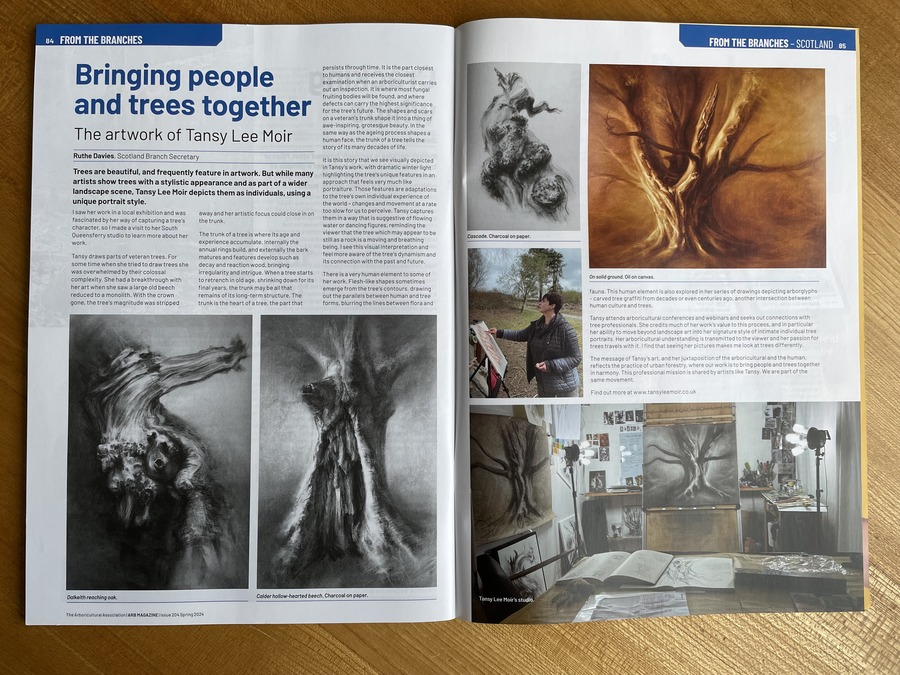 An article published in the Arboricultural Association members magazine Spring 2024, written by Ruthe Davis.
An article published in the Arboricultural Association members magazine Spring 2024, written by Ruthe Davis.
Trees are beautiful, and frequently feature in artwork. But while many artists show trees with a stylistic appearance and as part of a wider landscape scene, Tansy Lee Moir depicts them as individuals, using a deeply personal portrait style. I visited this artist in her South Queensferry studio to learn more about her work.
Tansy draws parts of veteran trees. She had a breakthrough with her art style when she saw a large old beech reduced to a monolith. With the crown gone, the colossal complexity of the tree was stripped back, and with it, her artistic focus closed in on the trunk.
The trunk of a tree is where its age and experience accumulates. Internally the annual rings build, and externally the bark matures and features develop such as decay and reaction wood, bringing irregularity and intrigue. When a tree starts to retrench in old age, shrinking down for its final years, the trunk may be all that remains of its long-term structure. The trunk is the heart of a tree, the part that persists through time. It is the part closest to humans and receives the closest examination when an arboriculturist carries out an inspection. It is where most fungal fruiting bodies will be found, and where defects can carry the highest significance for the tree’s future. The shapes and scars on a veteran’s trunk shape it into a thing of awe-inspiring, grotesque beauty, telling the story of its many decades of life.

It is this story that we see visually depicted in Tansy’s tree portraits, with dramatic winter light highlighting the tree’s unique features. Those features are adaptations to the tree’s own individual experience of the world – changes and movement at a rate too slow for us to perceive. Tansy captures them in a way that is suggestive of flowing water or dancing figures, reminding the viewer that the tree that may appear to be still as a rock is a moving and breathing being.
There is a very human element to some of her work. Flesh-like shapes sometimes emerge from the tree’s contours, drawing out the parallels between human and tree forms, blurring the lines between flora and fauna. This human element is also explored in her project drawing arborglyphs – carved tree graffiti from decades or even centuries ago, another intersection between human culture and trees.

Tansy attends arboricultural conferences and webinars and seeks out connections with tree professionals. She credits much of her work’s value to this process, and in particular her ability to move beyond landscape art into her signature style of intimate individual tree portraits. Her arboricultural understanding is transmitted to the viewer and a passion for trees can travel with it. I find that seeing her pictures makes me look at trees differently.
The message of Tansy’s art, and her juxtaposition of the arboricultural and the human, reflects the practice of urban forestry, where our work is to bring people and trees together in harmony. This professional mission is shared by artists like Tansy. We are part of the same movement.
Thanks to Ruthe Davis, City of Edinburgh Tree Officer for this lovely piece which she wrote following a studio visit last year.
The Arboricultural Association is the leading voice on all matters arboricultural in the UK – if you’re interested in learning more about trees, you can browse their free webinar archive here.